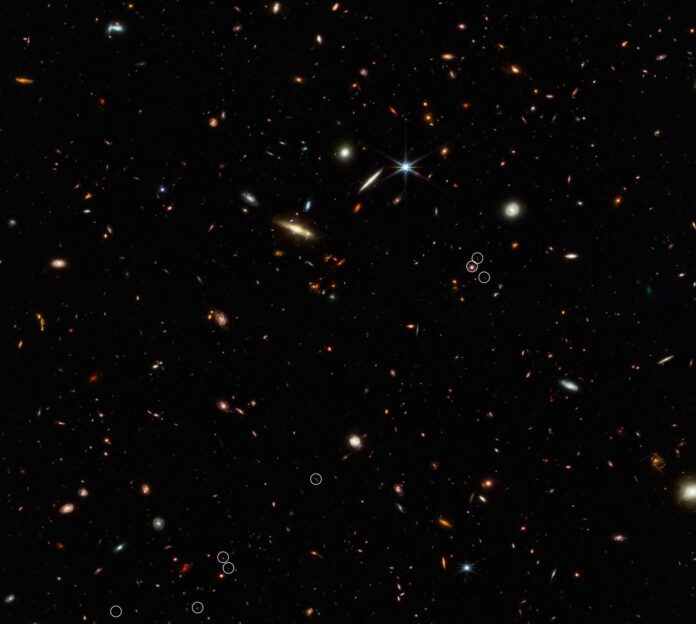Galaxies gather together to form a cluster and vast interconnected filamentary structures called cosmic web, with gigantic barren voids in between. This “cosmic web” was at first hazy, but throughout time, as gravity pulled things together, it grew more apparent.
By using NASA’s James Webb Space Telescope, astronomers have recently discovered the earliest strands of the cosmic web. They have discovered a thread-like arrangement of 10 galaxies that existed just 830 million years after the big bang.
The 3 million light-year-long structure is anchored by a luminous quasar – a galaxy with an active, supermassive black hole at its core. The team believes the filament will eventually evolve into a massive cluster of galaxies, much like the well-known Coma Cluster in the nearby universe.
Team member Xiaohui Fan of the University of Arizona in Tucson said, “I was surprised by how long and narrow this filament is. I expected to find something but didn’t expect such a long, distinctly thin structure.”
Feige Wang of the University of Arizona in Tucson said, “This is one of the earliest filamentary structures that people have ever found associated with a distant quasar.”
The ASPIRE project, whose major objective is to investigate the cosmic environs of the first black holes, made this discovery. ASPIRE stands for A SPectroscopic survey of biassed halos in the Reionization Era. The program will study 25 active quasars during the Epoch of Reionization, the first billion years following the Big Bang.
Team member Joseph Hennawi of the University of California, Santa Barbara, said, “The last two decades of cosmology research have given us a robust understanding of how the cosmic web forms and evolves. ASPIRE aims to understand how to incorporate the emergence of the earliest massive black holes into our current story of cosmic structure formation.”
The study also looks into the characteristics of eight quasars in the young universe. The group verified that the central black holes’ masses, which ranged from 600 million to 2 billion times that of the Sun and were created less than a billion years after the big bang, are in the range stated. Astronomers are still looking for proof to explain how these black holes might enlarge quickly.
Wang said, “To form these supermassive black holes quickly, two criteria must be satisfied. First, you must start growing from a massive ‘seed’ black hole. Second, even if this seed starts with a mass equivalent to a thousand Suns, it still needs to accrete a million times more matter at the maximum possible rate for its entire lifetime.”
Jinyi Yang of the University of Arizona, who is leading the study of black holes with ASPIRE, said, “These unprecedented observations are providing important clues about how black holes are assembled. We have learned that these black holes are situated in massive young galaxies that provide the reservoir of fuel for their growth.”
The strongest proof of how early supermassive black holes might control star formation in their host galaxies was also provided by Webb. While accreting matter, supermassive black holes are also capable of enormous material outflows. On a galactic scale, these winds can spread far beyond the black hole itself and considerably influence the star-forming process.
Yang said, “Strong winds from black holes can suppress the formation of stars in the host galaxy. Such winds have been observed in the nearby universe but have never been directly observed in the Epoch of Reionization. The scale of the wind is related to the structure of the quasar. In the Webb observations, we see that such winds existed in the early universe.”
Journal Reference:
- Feige Wang, Jiyi Yang, Joseph Hennawi et al. A SPectroscopic Survey of Biased Halos in the Reionization Era (ASPIRE): JWST Reveals a Filamentary Structure around a z = 6.61 Quasar. The Astrophysical Journal Letters. DOI 10.3847/2041-8213/accd6f
